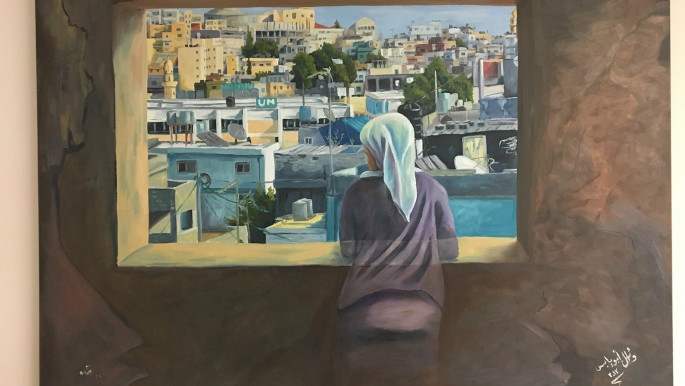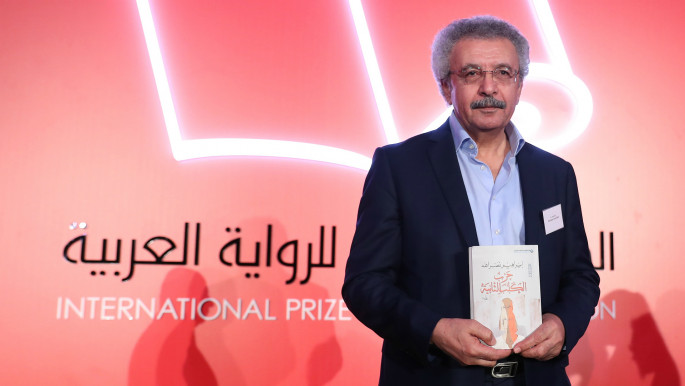Empathy, education and inspiration: One Palestinian's vision for art in Washington
Originally from Palestine, Ahmed was born and raised in the Dheisheh refugee camp, which was established in 1948 within the city of Bethlehem, and where nearly 20,000 people reside today.
"I was born there. I went to high school there. I went to college in Jerusalem, and after I finished college, I moved to the US," the artist reveals.
He met Bshara Nassar, the director of the Museum of the Palestinian People, in Washington in 2014.
"He was telling me about the idea of creating a museum and I really welcomed that," Ahmed tells The New Arab. "In my time in Palestine, I worked on art in Bethlehem, Ramallah and Jerusalem, usually focusing on art workshops with international artists. I worked on murals within the camps including commemoration murals. My degree was in liberal arts, focusing on international law, and my minor was in literature. After doing my Master's in law, I moved to DC."
 |
A space that creates empathy, that educates and inspires people about the plight and history of the Palestinian people and a space where Palestinians could feel at home |  |
Read also: Trump can kill Oslo, but not Palestinian national aspirations
 |
|
| Read also: Celebrating Palestine with Washington's new 'cultural embassy' |
"At the beginning, it was the Nakba museum, creating a museum for Palestinians to commemorate the Nakba. Even in Palestine there is no Nakba Museum," he explains.
"DC, on the other hand, is a city full of many museums and with free admission. I said to Bshara, a museum is a great idea. There is the national art gallery, there is the holocaust museum and many others – so why not have a Palestinian museum? Or the Nakba museum? People could know about the Palestinian catastrophe."
It was after this they began working on the Washington project.
"I went back to Palestine as I know many artists there and started reaching out to them. Some gave me ideas while others donated artwork. The art scene in Palestine is much, much stronger than the art scene here I think. The artists there are always busy, always producing and always selling.
"There is a strong art community, especially in Bethlehem, Jerusalem and Ramallah. We started recording artists and shipping their art to DC."
The first exhibit took place in 2015. "We had an opening and we had a curator at that time who volunteered with us. She did a great curation for the space and it was a very professional exhibition," Ahmed tells The New Arab.
The first show exhibited five paintings all dedicated to the Nakba.
"It was very successful. We had more than a thousand people who visited within 10 days," says Ahmed.
"We were surprised by the reaction of the community in DC, how many people came, even people who had no clue about Palestinians or the conflict or the Nakba. It wasn't just an art exhibit, it was more an educational space, because we had partitions with sliders, with panels that shows you the history, what happened before the Nakba in 1948, what was the political landscape, what happened during the war, what happened in the aftermath, so all of this."
 |
We noticed that the current Palestinian dialogue, the current Palestinian conversation is about victimhood, about suffering... We thought let's make something different, something about resilience, something with more of an optimistic approach |  |
Talking about the the vision for the museum, Ahmed wants it to be universal and inclusive – a space that creates empathy, that educates and inspires people about the plight and history of the Palestinian people, while also a space where Palestinians can feel at home.
Ahmed explains that after a lot of brainstorming sessions, they decided to change the name of the museum.
"We are trying to be different from other institutions in the same field," he explained. "We noticed that the current Palestinian dialogue, the current Palestinian conversation is about victimhood, about suffering, about going back, you know. So as a team we thought let's make something different, something about resilience, something with more of an optimistic approach, instead of focusing on these negative things.
"Definitely we respect history and we are not going to change what happened in the past because what happened has already happened, but we need to do something different, to think out of the box," he adds.
 |
|
| Read also: 'Books are freedom and hope': Palestinian-Jordanian author Ibrahim Nasrallah on life and literature |
"Palestinian people are everywhere, and we wanted to include them all, not just those in the West Bank or Gaza. If you go to Chile you find huge towns of Palestinians. Can you imagine, in Chile? There is a town there called Bethlehem, there are 70,000 people from Bethlehem there. We wanted the name to be inclusive to all."
The Nakba Museum then went on to become the The Museum of the Palestinian People.
Read also: Trump's endgame in Palestine
"Commemorating people would fit with this approach, whether that be sad events or the good figures in history," Ahmed continues. "If we stayed with that vision, the Nakba, you limit yourself, I think. I might be wrong, but I think within this approach, we are more inclusive. It gives us wiggle room to move from one topic to another."
But with the current political situation and the Trump administration, does Ahmed think art has the ability to transcend these sorts of politics, or speak more directly to people?
"This reminds me of Voltaire when he says – the writer could tell simple things in a very complicated way, but artists tell things in a very simple way," Ahmed replies.
"The political situation has not been on our side for a long time – whether it's under Trump or someone else; it wasn't going in the best direction. Maybe this time it's going in another direction, but we are working on artistic project, an educational project, and we leave [the politics] for the people. The political situation is a reality we cannot change, but maybe in the future it will change.
"We have an upcoming exhibition on reimagining the future – there is a need to reimagine the future, subjectively. I made a survey to get ideas, on 'how would you imagine this,' but the majority of respondents were stuck in the reality... But it's still nice to try, to attempt to reimagine the future."
Follow her on Twitter @rswrdn





 Follow the Middle East's top stories in English at The New Arab on Google News
Follow the Middle East's top stories in English at The New Arab on Google News


